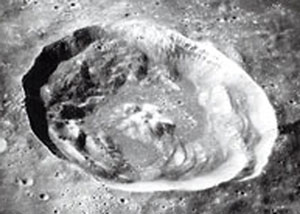Source: NASA
10-19-2007 11:51
 |
Euler Crater has central peaks and slumped walls. The peaks almost certainly formed quickly after the impact that produced the crater compressed the ground. The ground rebounded upward, forming the peaks. The crater walls are slumped because the original walls were too steep to withstand the force of gravity. Material fell inward, away from the walls. This crater, in Mare Imbrium (Sea of Rains), is about 17 1/2 miles (28 kilometers) across. Image credit: Lunar and Planetary Institute.
The vast majority of the moon's craters are formed by the impact of meteoroids, asteroids, and comets. Craters on the moon are named for famous scientists. For example, Copernicus Crater is named for Nicolaus Copernicus, a Polish astronomer who realized in the 1500's that the planets move about the sun. Archimedes Crater is named for the Greek mathematician Archimedes, who made many mathematical discoveries in the 200's B.C.
The shape of craters varies with their size. Small craters with diameters of less than 6 miles (10 kilometers) have relatively simple bowl shapes. Slightly larger craters cannot maintain a bowl shape because the crater wall is too steep. Material falls inward from the wall to the floor. As a result, the walls become scalloped and the floor becomes flat.
Still larger craters have terraced walls and central peaks. Terraces inside the rim descend like stairsteps to the floor. The same process that creates wall scalloping is responsible for terraces. The central peaks almost certainly form as did the central peaks of impact craters on Earth. Studies of the peaks on Earth show that they result from a deformation of the ground. The impact compresses the ground, which then rebounds, creating the peaks. Material in the central peaks of lunar craters may come from depths as great as 12 miles (19 kilometers).
Surrounding the craters is rough, mountainous material -- crushed and broken rocks that were ripped out of the crater cavity by shock pressure. This material, called the crater ejecta blanket, can extend about 60 miles (100 kilometers) from the crater.
Farther out are patches of debris and, in many cases, irregular secondary craters, also known as secondaries. Those craters come in a range of shapes and sizes, and they are often clustered in groups or aligned in rows. Secondaries form when material thrown out of the primary (original) crater strikes the surface. This material consists of large blocks, clumps of loosely joined rocks, and fine sprays of ground-up rock. The material may travel thousands of miles or kilometers.
Crater rays are light, wispy deposits of powder that can extend thousands of miles or kilometers from the crater. Rays slowly vanish as micrometeoroid bombardment mixes the powder into the upper surface layer. Thus, craters that still have visible rays must be among the youngest craters on the moon.
